Polypill Products Market Size and Share
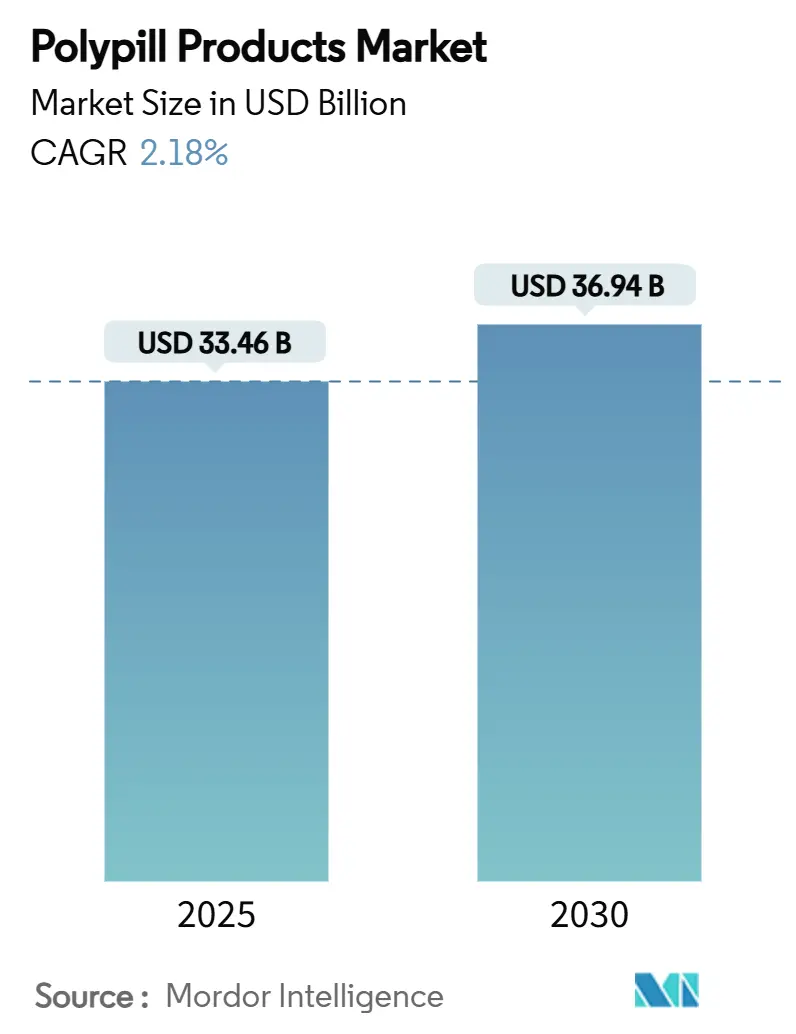
Polypill Products Market Analysis by Mordor Intelligence
The Polypill Products Market size is estimated at USD 33.46 billion in 2025, and is expected to reach USD 36.94 billion by 2030, at a CAGR of 2.18% during the forecast period (2025-2030).
Mounting clinical evidence, the World Health Organization (WHO) essential medicines listing, and supportive regulatory milestones have transformed fixed-dose combinations from experimental concepts into mainstream preventive cardiology tools. Triple-class polypills continue to set the commercial pace, while the first U.S. approval of a triple combination for initial hypertension therapy is widening physician confidence in fixed regimens. Geographic momentum is shifting toward Asia Pacific, where rising cardiovascular prevalence and infrastructure investment underpin the strongest regional growth outlook. Competitive intensity remains moderate as multinational innovators compete with cost-advantaged regional manufacturers. Yet, recent approvals and pipeline investments suggest accelerated product-launch frequency, especially for ultra-low-dose quadruple combinations and digital-health-enabled offerings.
Key Report Takeaways
- By product type, triple-class combinations held 43.23% of polypill products market share in 2024, while quad-or-higher-class formulations are forecast to expand at a 4.31% CAGR through 2030.
- By composition, statin + antihypertensive combinations commanded 32.87% share of the polypill products market size in 2024; statin + antihypertensive + antiplatelet triple formulations are projected to grow at a 3.94% CAGR to 2030.
- By application, cardiovascular disease prevention accounted for a 67.48% share of the polypill products market size in 2024 and stroke prevention is advancing at a 5.31% CAGR through 2030.
- By distribution channel, hospital pharmacies led with 53.14% revenue share in 2024, while online pharmacies post the highest projected CAGR at 4.94% to 2030.
- By geography, North America dominated with 40.64% share in 2024; Asia Pacific records the fastest regional CAGR at 6.84% over the forecast horizon.
Global Polypill Products Market Trends and Insights
Drivers Impact Analysis
| Driver | (~) % Impact on CAGR Forecast | Geographic Relevance | Impact Timeline |
|---|---|---|---|
| Rising prevalence of CVD & hypertension | +1.2% | Global, early gains in Asia Pacific and North America | Medium term (2-4 years) |
| Growing clinical-trial evidence & R&D pipelines | +0.8% | Global | Long term (≥ 4 years) |
| Improved adherence vs multi-pill regimens | +0.9% | Global, spill-over to LMIC markets | Short term (≤ 2 years) |
| Demonstrated cost-effectiveness of FDC therapy | +0.7% | LMIC core, expansion to developed markets | Medium term (2-4 years) |
| WHO EML listing catalyzing LMIC procurement | +0.6% | Asia Pacific, Africa, Latin America | Short term (≤ 2 years) |
| Digital-health subscription models for polypills | +0.4% | North America & EU, early urban Asia | Long term (≥ 4 years) |
| Source: Mordor Intelligence | |||
Rising Prevalence of CVD & Hypertension
Roughly 127.9 million U.S. adults, 48.6% of the population, now live with at least one cardiovascular condition, creating a steadily enlarging treatment-eligible cohort.[1]American Heart Association, “Heart and Stroke Statistics 2025,” heart.org Hypertension affects more than 1.2 billion individuals worldwide, yet control rates sit below 50% in significant economies, underscoring a persistent therapeutic gap that polypills can close. Population aging in high-income countries and urban lifestyle shifts in emerging markets together sustain this demand trajectory. Non-Hispanic Black communities in the United States disproportionately carry the cardiovascular burden, making simplified fixed-dose regimens an equity-oriented intervention. As health systems intensify preventive strategies, seamless multi-mechanism control delivered by single tablets is gaining prescriber mindshare, reinforcing growth in the polypill products market.
Growing Clinical-Trial Evidence & R&D Pipelines
Meta-analyses of 26 randomized controlled trials now show an 11% mortality reduction and 29% cut in cardiovascular events with polypill therapy versus usual care.[2]Nature Medicine, “Fixed-Dose Combination Meta-Analysis,” nature.com The SECURE trial delivered a 24% drop in major adverse cardiovascular events in secondary prevention, while the PolyPars study reported a 50% risk reduction in primary prevention settings.[3]NEJM, “SECURE Trial Results,” nejm.org Pharmaceutical majors responded with deeper pipelines; AstraZeneca lists 189 cardiovascular projects and Merck recently licensed HRS-5346, a first-in-class oral lipoprotein(a) inhibitor. The FDA’s 2025 clearance of Widaplik as initial hypertension therapy shifted polypills from last-resort status to first-line options, accelerating global regulatory review queues. Collectively, these milestones add scientific and commercial credibility, powering the polypill products market forward.
Improved Adherence vs Multi-Pill Regimens
Average medication adherence rises from 63.2% with usual care to 74.1% when patients receive fixed-dose combinations. The FOCUS project found polypill adherence at 50.8% compared with 41% on separate agents, with the elderly reaping the greatest benefit. In a 24-country physician survey, 82% rated polypills valuable for tackling non-adherence, and 80% cited pill-burden reduction as critical. Real-world studies confirm that simplifying regimens improves long-term outcomes and lowers total healthcare expenditure, bolstering payor acceptance. Elevated adherence metrics underpin consistent clinical benefit, amplifying demand for integrated cardiovascular therapies and consolidating the polypill products market.
Demonstrated Cost-Effectiveness of FDC Therapy
Incremental cost-effectiveness ratios, comfortably inside accepted thresholds across advanced economies. Australia’s Kanyini GAP trial showed USD 989 in annual per-patient drug-cost savings, while U.K. modeling projects that just 10% polypill uptake could avert 3,260 cardiovascular events and 590 deaths in ten years. In LMICs, polypills prevent 40-54 major events per 1,000 patients over five years for USD 64-364 per DALY averted. With generic entries, monthly therapy costs equate to 0.2-2.8 days’ wages in markets such as India and Mauritius, enhancing affordability. The robust economic case reinforces uptake among cost-conscious health ministries and insurers, directly fueling the polypill products market.
Restraints Impact Analysis
| Restraint | (~) % Impact on CAGR Forecast | Geographic Relevance | Impact Timeline |
|---|---|---|---|
| Safety & adverse-event heterogeneity concerns | -0.6% | Global, regulatory focus in developed markets | Medium term (2-4 years) |
| Complex multi-agency regulatory approvals | -0.8% | Global, notably North America & EU | Long term (≥ 4 years) |
| Formulation stability in hot/humid climates | -0.4% | Asia Pacific, Africa, Latin America | Short term (≤ 2 years) |
| Absent reimbursement codes & payer reluctance | -0.9% | North America core, expanding to developed markets | Medium term (2-4 years) |
| Source: Mordor Intelligence | |||
Safety & Adverse-Event Heterogeneity Concerns
The combined risk profiles of constituent drugs heighten vigilance over hypotension, renal effects, and metabolic changes, complicating routine pharmacovigilance. Physicians worry about tweaking individual doses once patients encounter side effects, and regulators demand population-wide safety evidence, prolonging development timelines. Post-market surveillance must parse which active agent drives an adverse event complex task that can deter prescribers, dampening near-term uptake in cautious markets.
Complex Multi-Agency Regulatory Approvals
Approvals require proof of individual component efficacy, bioequivalence to free combinations, and clinical superiority of the fixed ratio. The Widaplik review entailed extensive Phase III head-to-head data versus dual therapy and placebo, setting rigorous precedents others must follow. Lack of global harmonization forces separate submissions and divergent data packages, adding cost and slowing multi-region launches.
Segment Analysis
By Product Type: Multi-Class Combinations Drive Therapeutic Innovation
Triple-class formulations delivered 43.23% revenue in 2024, illustrating entrenched physician trust in comprehensive risk-factor coverage and serving as anchors for first-line therapy after the Widaplik approval. Quad-or-higher designs post a 4.31% CAGR and spearhead innovation by lowering each component dose to minimize side-effects without efficacy loss. The QUARTET USA trial validated four-drug, quarter-dose strategies, achieving notable blood-pressure reductions and 80% patient satisfaction. These data accelerate clinician migration away from step-wise titration toward immediate multi-pathway control, buttressing the polypill products market size in advanced care models. Dual-class and single-class subsets retain niche relevance for titration flexibility but face gradual share erosion as guidelines endorse broader adoption of multi-class tablets.
Ultra-low-dose quadruple tablets illustrate the shift toward maximized risk-factor suppression with minimized tolerability trade-offs. Systematic reviews show 90% achievement of target blood pressure and mild adverse-event profiles rarely prompting discontinuation. As real-world familiarity grows, payors recognize hospitalization-avoidance benefits, and the polypill products market share of quad-class offerings is set for incremental uptake through 2030.
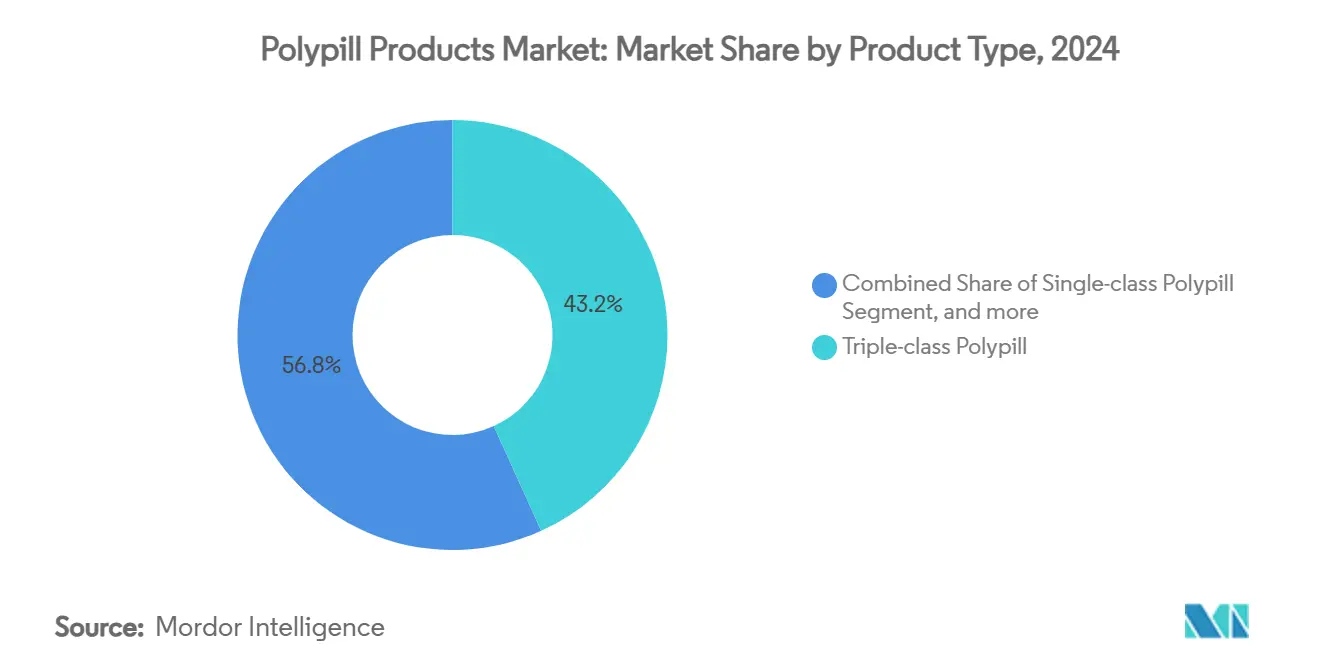
Note: Segment shares of all individual segments available upon report purchase
By Composition: Statin-Based Combinations Lead Evidence-Based Prevention
Statin + antihypertensive formulations held 32.87% share in 2024, underpinned by decades of safety data and WHO endorsement of atorvastatin-based combinations. Fixed atorvastatin + amlodipine 5/20 mg tablets significantly cut composite endpoints versus free combinations, cementing their role in secondary prevention. Incorporating antiplatelets elevates risk-reduction potential; the CNIC polypill secured EMA approval for secondary-prevention use, and triple-component blends now expand at a 3.94% CAGR. As broader access materializes, especially in LMIC tenders, the polypill products market size for triple-class statin combinations is poised for strategic scale.
Emergent formulations include PCSK9 or SGLT2 inhibitors alongside statins, tackling residual lipid and metabolic risk. South Korea’s 2025 approval of NUVOROZET, a telmisartan/rosuvastatin/amlodipine/ezetimibe quartet illustrates regulatory openness to multi-mechanism tablets targeting persistent dyslipidemia unmet needs. These innovations diversify therapeutic arsenals and deepen competitive moats for early entrants.
By Application: Prevention Strategies Dominate Therapeutic Focus
Prevention uses represented 67.48% of 2024 demand as health systems pivot toward proactive population management. The SECURE trial’s 24% event-reduction evidence resonated with guideline committees, embedding polypills in secondary-prevention algorithms. Primary prevention is next in line, especially in LMICs where streamlined access offsets clinician scarcity.
Stroke prevention logs the fastest 5.31% CAGR, fueled by AHA/ASA 2024 guidance targeting 130/80 mmHg blood-pressure thresholds and multi-risk-factor control. Studies of cilostazol-based dual antiplatelets cut ischemic events by 54% in East Asian cohorts, fostering exploration of regionalized stroke-focused polypillls. As new evidence envelopes intracerebral-hemorrhage survivors, the addressable cerebrovascular market widens, lifting polypill products market share in neurology-aligned segments.
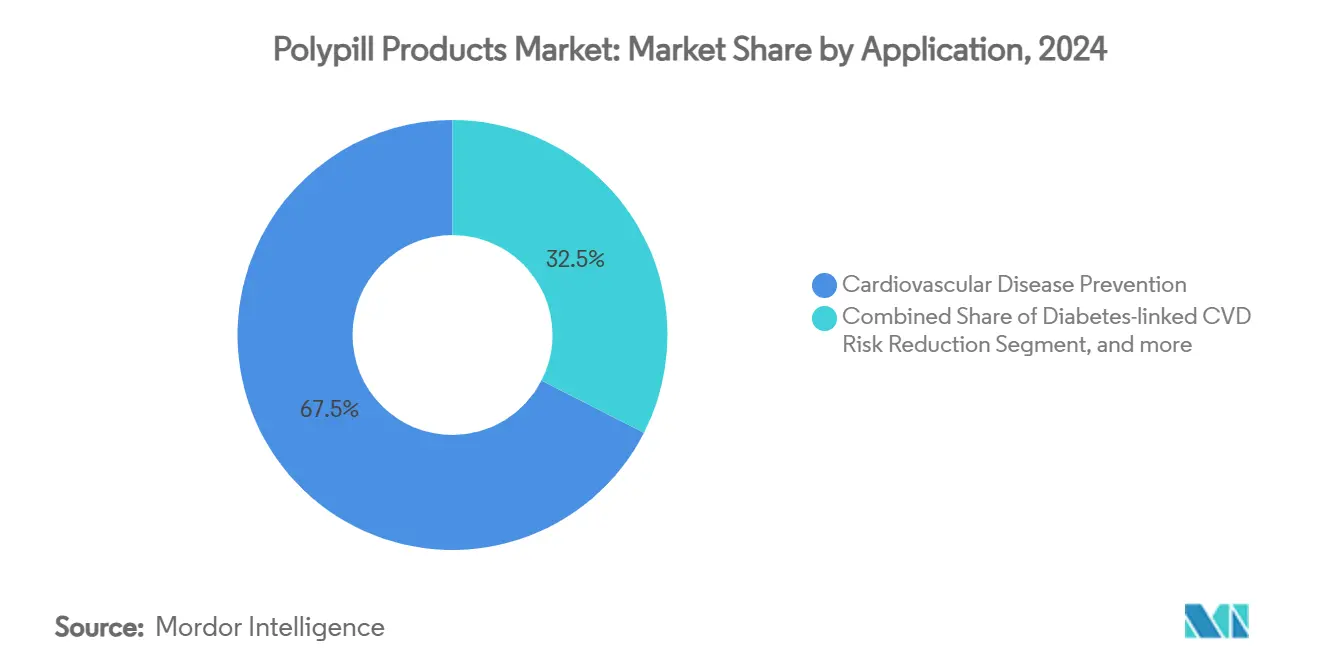
Note: Segment shares of all individual segments available upon report purchase
By Distribution Channel: Hospital Dominance Faces Digital Disruption
Hospital pharmacies generated 53.14% of 2024 value as inpatient teams initiate therapy before discharge, ensuring dose stabilization and specialist oversight. Formularies leverage bulk procurement to offset cost hurdles, but complex payer rules still stifle outpatient continuity. Pharmacies in community settings shoulder transition-of-care education but struggle with coverage ambiguity.
Online channels grow at 4.94% CAGR through 2030 on convenience, competitive pricing, and integrated digital-adherence services. Twelve consumer drivers, from delivery speed to platform trust, influence purchase intention more than demographic traits, suggesting broad market receptivity. High-performance mobile-health apps sync prescription refills with clinician dashboards, reinforcing adherence and positioning e-pharmacies as logical polypill gateways in chronic-disease ecosystems. This convergence of commerce and care is a material tailwind for the polypill products market.
Geography Analysis
North America supplied 40.64% of 2024 sales, thanks to sophisticated reimbursement, clinical-trial infrastructure, and the Widaplik endorsement for first-line hypertension management. The United States hosts 122 million hypertensive adults, yet under-50% control rates underline substantial headroom for adoption. Canada’s centralized drug review accelerates provincial coverage, while Mexico’s Seguro Popular reforms sustain fixed-dose procurement. Regional R&D hubs yield pivotal datasets such as QUARTET USA, which further mainstream combination strategies.
Asia Pacific records the fastest 6.84% CAGR on enlarging middle-class demographics, lifestyle shifts, and improving primary-care reach. India’s manufacturers, typified by Cipla with 10% cardiac-portfolio growth, drive price-competitive supply for domestic and export markets. China’s 2024 hypertension guidelines highlight combination-therapy utility, and South Korea’s NUVOROZET approval reflects regulatory momentum. Japan and Australia advance clinical-research pipelines and digital-health integration, reinforcing regional leadership in technology-enabled cardiology.
Europe, the Middle East & Africa, and South America together form a heterogeneous opportunity landscape. Europe benefits from EMA’s CNIC-polypill clearance, anchoring secondary-prevention protocols. Procurement pipelines in Nigeria and Kenya gain impetus from WHO’s essential medicines listing, while affordability levels in Argentina (0.2-2.8 days’ wages for monthly therapy) demonstrate economic feasibility. Market-entry strategies must flex to divergent regulatory, reimbursement, and infrastructure conditions, yet rising cardiovascular morbidity supports sustained demand across all three continents.
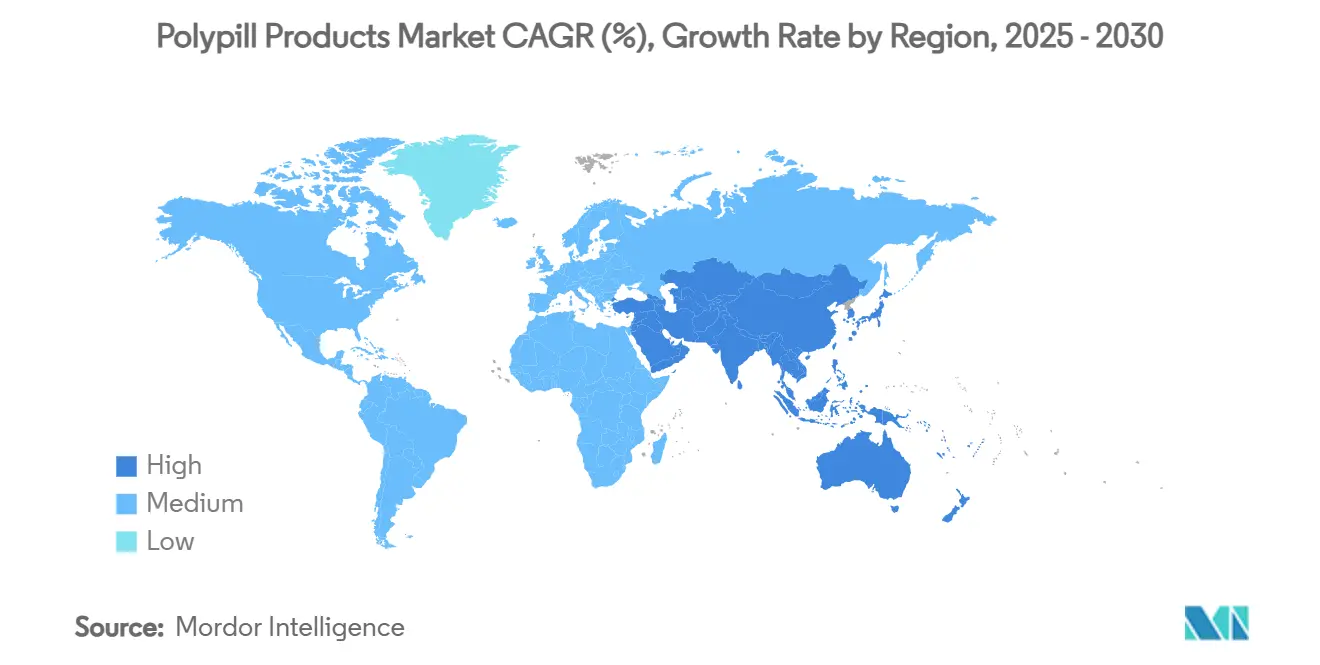
Competitive Landscape
The polypill products market features moderate concentration where global majors coexist with agile regional producers. AstraZeneca anchors the innovation frontier, allocating USD 1.9 billion to lipoprotein(a) disruptors and projecting USD 80 billion group revenue by 2030. PURSUIT Phase IIb data show the company’s AZD0780 oral PCSK9 inhibitor cut LDL cholesterol by 50.7%, raising prospect of next-generation multi-mechanism polypills. Merck reinforces external innovation by licensing HRS-5346 from Jiangsu Hengrui and collaborating with Daiichi Sankyo on MK-6070, broadening its cardiovascular toolkit.
Regional players like Cipla grow through cost-optimized manufacturing and entrenched distribution, posting 10% annual cardiac-business gains and supplying emerging-market tenders. Technological differentiation emerges as 3D printing enables personalized pill layering, while excipient advances battle tropical degradation. Strategic alliances supply, codevelopment, and digital-health partnerships will shape market access, labeling AstraZeneca, Merck, Cipla, and CNIC as pivotal shapers of future polypill products market dynamics.
As the competitive set widens, success will hinge on evidence-rich dossiers, robust manufacturing for climate resilience, digital-first adherence services, and pricing flexibility compatible with diverse payer models.
Polypill Products Industry Leaders
-
AstraZeneca
-
Cadila Pharmaceuticals
-
Cipla, Inc.
-
Dr Reddy’s Laboratories
-
Janssen (Johnson & Johnson)
- *Disclaimer: Major Players sorted in no particular order
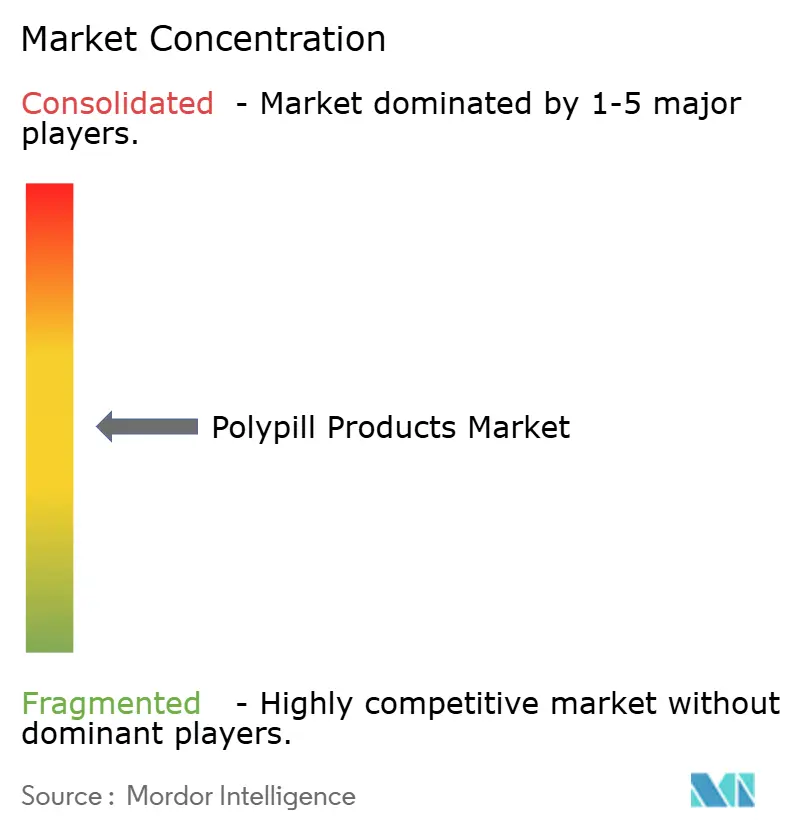
Recent Industry Developments
- June 2025: FDA approved Widaplik (telmisartan/amlodipine/indapamide), the first triple-combination polypill for initial hypertension treatment, marking a paradigm shift toward polypills as first-line therapy rather than salvage options for complex patients.
- May 2025: Merck entered exclusive licensing agreement with Jiangsu Hengrui Pharmaceuticals for HRS-5346, an investigational oral lipoprotein(a) inhibitor, expanding the competitive landscape for novel cardiovascular targets beyond traditional polypill components.
- March 2025: South Korea's Ministry of Food and Drug Safety approved NUVOROZET, a four-component cardiovascular polypill combining telmisartan, rosuvastatin, amlodipine, and ezetimibe, demonstrating regulatory acceptance of comprehensive combination approaches in Asian markets.
- March 2025: AstraZeneca's AZD0780 oral PCSK9 inhibitor demonstrated 50.7% LDL cholesterol reduction in PURSUIT Phase IIb trial, with 84% of participants achieving target levels compared to 13% on statins alone, advancing next-generation polypill component development.
Global Polypill Products Market Report Scope
As per the scope of the report, polypill products are a fixed-dose combination of several other combinations of drugs targeting different parameters of the disease.
The polypill products market is segmented by type (single-parameter polypill, multi-parameter polypill), application (cardiovascular, diabetes mellitus, other applications), distribution channel (online pharmacies, hospital pharmacies, retail pharmacies), and geography (North America, Europe, Asia-Pacific, Middle East, Africa, and South America). The market report also covers the estimated market sizes and trends for 17 different countries across major regions globally.
The report offers the value (in USD) for the above segments.
| Single-class Polypill |
| Dual-class Polypill |
| Triple-class Polypill |
| Quad-or-higher-class Polypill |
| Statin + Antihypertensive |
| Antihypertensive + Antiplatelet |
| Statin + Antihypertensive + Antiplatelet |
| Others |
| Cardiovascular Disease Prevention |
| Diabetes-linked CVD Risk Reduction |
| Stroke Prevention |
| Others |
| Hospital Pharmacies |
| Retail Pharmacies |
| Online Pharmacies |
| North America | United States |
| Canada | |
| Mexico | |
| Europe | Germany |
| United Kingdom | |
| France | |
| Italy | |
| Spain | |
| Rest of Europe | |
| Asia-Pacific | China |
| Japan | |
| India | |
| Australia | |
| South Korea | |
| Rest of Asia-Pacific | |
| Middle East & Africa | GCC |
| South Africa | |
| Rest of Middle East & Africa | |
| South America | Brazil |
| Argentina | |
| Rest of South America |
| By Product Type | Single-class Polypill | |
| Dual-class Polypill | ||
| Triple-class Polypill | ||
| Quad-or-higher-class Polypill | ||
| By Composition | Statin + Antihypertensive | |
| Antihypertensive + Antiplatelet | ||
| Statin + Antihypertensive + Antiplatelet | ||
| Others | ||
| By Application | Cardiovascular Disease Prevention | |
| Diabetes-linked CVD Risk Reduction | ||
| Stroke Prevention | ||
| Others | ||
| By Distribution Channel | Hospital Pharmacies | |
| Retail Pharmacies | ||
| Online Pharmacies | ||
| By Geography | North America | United States |
| Canada | ||
| Mexico | ||
| Europe | Germany | |
| United Kingdom | ||
| France | ||
| Italy | ||
| Spain | ||
| Rest of Europe | ||
| Asia-Pacific | China | |
| Japan | ||
| India | ||
| Australia | ||
| South Korea | ||
| Rest of Asia-Pacific | ||
| Middle East & Africa | GCC | |
| South Africa | ||
| Rest of Middle East & Africa | ||
| South America | Brazil | |
| Argentina | ||
| Rest of South America | ||
Key Questions Answered in the Report
How large is the polypill products market in 2025?
The polypill products market size stands at USD 33.46 billion in 2025, with a 2.18% CAGR forecast to 2030.
Which product type currently leads sales?
Triple-class combinations hold the largest share at 43.23% of 2024 revenue.
Which region is growing fastest for polypill adoption?
Asia Pacific records the strongest CAGR at 6.84% through 2030.
What recent regulatory milestone is shaping U.S. uptake?
The FDA’s June 2025 approval of Widaplik established triple polypills as first-line hypertension therapy.
Why are online pharmacies important to future sales?
Online channels offer convenience, competitive pricing, and digital-adherence tools, driving a 4.94% CAGR in distribution.
Which company is investing heavily in next-generation polypills?
AstraZeneca allocated USD 1.9 billion to lipoprotein(a) disruptors and leads 3-and-4 drug pipeline development.
Page last updated on:



